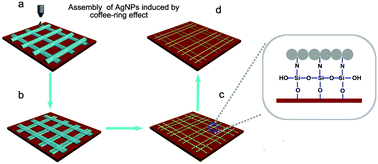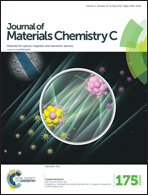Interfacial adhesion enhancement of ink-jet printed transparent metallic grid electrodes induced by the coffee-ring effect†
Abstract
An effective and facile strategy was developed to regulate the surface characteristics of silver nanoparticles (AgNPs), and enormously enhance interfacial adhesion between transparent metal grid electrodes and the substrates. In this work, (3-aminopropyl)-trimethoxysilane (APTS) molecules were chosen as adhesion promoters to improve the surface characteristics of AgNPs and attain an excellent printability. Based on the coffee-ring effect, a series of transparent metallic grids with 5–8 μm line width were fabricated by ink-jet printing the as-synthesized AgNPs on the hydrophilic substrates. Due to the fact that the methoxy groups of APTS molecules could be covalently bonded to hydroxyl groups on the substrate surfaces, whereas amino groups reacted with AgNP surfaces to form AgNP–N bonds, a highly transparent AgNP grid-based electrode was successfully achieved with high interfacial adhesion strength. A transmittance of up to 92.6% could be achieved and the sheet resistance was less than 36.5 Ω sq−1. This simple, efficient and nonlithographic approach would be considered a universal method to construct tailored microstructures for the fabrication of optoelectronic devices.


 Please wait while we load your content...
Please wait while we load your content...